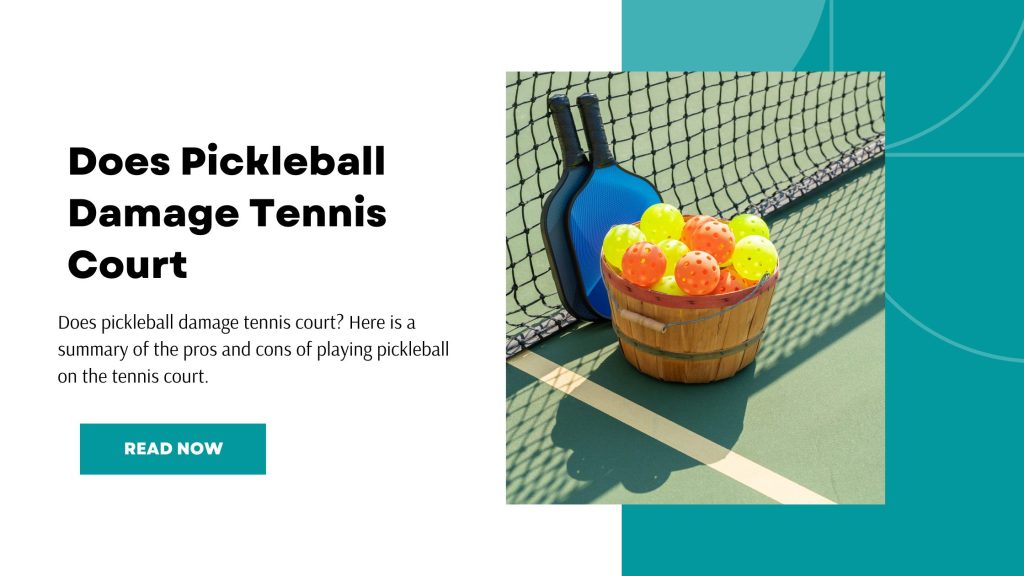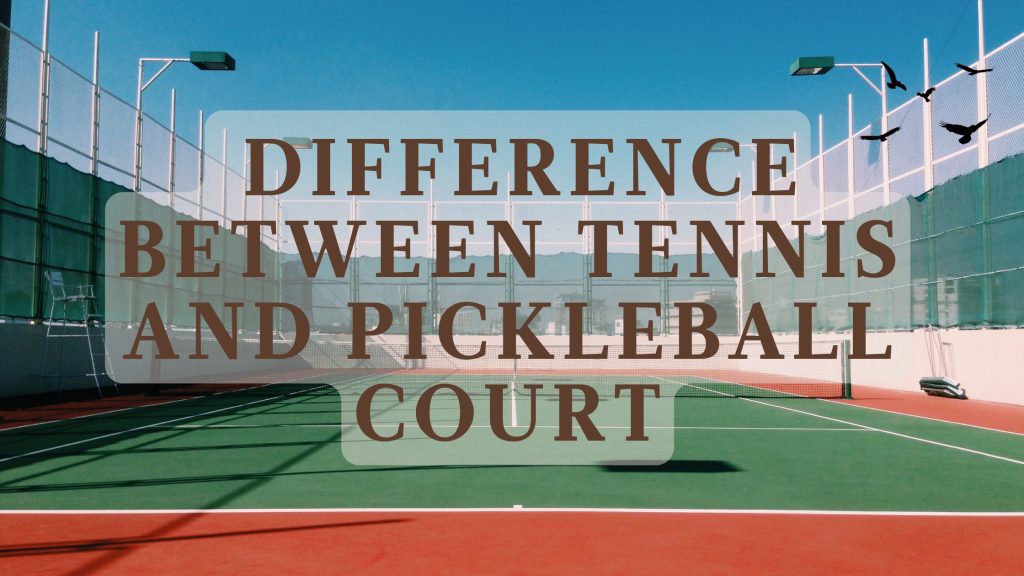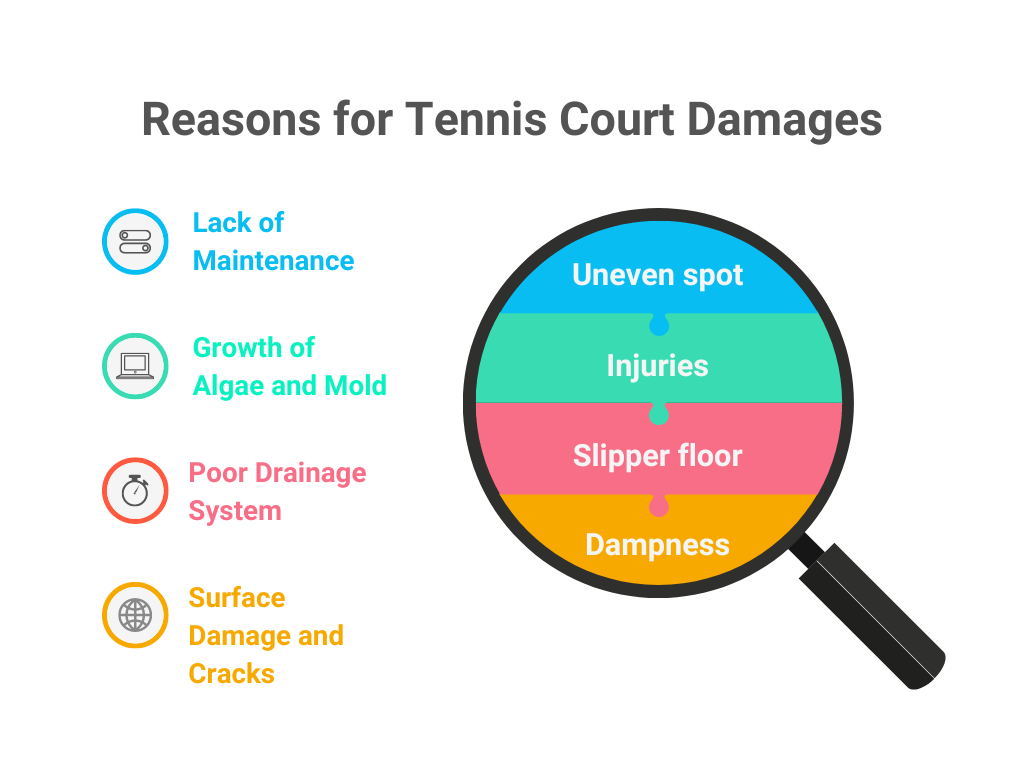Pickleball is not a strenuous activity and can be enjoyed with just a paddle and a ball similar to the wiffle ball. The game can be played on both tennis and badminton courts. One may question whether pickleball has the potential to harm a tennis court. However, this is false. Does Pickleball Damage Tennis Court?
Pickleball is an energetic activity that doesn’t cause wear and tear to a tennis court. Instead of the usual tennis racket, it requires a relatively smaller paddle, and the ball used is similar to that of a Wiffle ball. Tennis courts are well-equipped to handle this kind of game as they have considerable durability.
It is implausible that the tennis court will be damaged due to pickleball play.

Difference Between Tennis and Pickleball Courts
Pickleball and tennis are both fun and exciting, but the courts on which they are played have some distinct differences. There are several differences between a pickleball court and a tennis court. Here are a few:
- Size: Pickleball courts are not as large as tennis courts. Generally, they measure around one-third the width of a tennis court and have an approximate length of 20 feet by 44 feet.
- Net height: In pickleball, the net is lower than in tennis; specifically, it is set to 34 inches at the center, whereas in tennis, it stands at 36 inches.
- Ball: Pickleball uses a perforated plastic ball slightly larger than a golf ball, while tennis uses a rubber ball.’
- Racquets: Pickleball paddles are shorter and broader than tennis racquets and are usually crafted from graphite or composite materials. Tennis racquets usually have a longer and thinner shape, often constructed of aluminum or other metals.
- Scoring: In pickleball, players score a point only when they are serving. In tennis, players score a point every time they win a rally.
- Service: In pickleball, players must utilize an underhand technique to serve the ball and must permit the ball to make contact with the ground before striking. In contrast, tennis requires players to perform an overhand serve, and they do not need to let it touch the ground before hitting it.

Reasons for Tennis Court Damages
There is an assumption that playing pickleball on a tennis court will cause harm to it in all facets. However, this is untrue. Participating in another sport on a tennis court, particularly one that isn’t as intense as tennis, does not damage the court.
Some other factors play an essential part in damaging the tennis court. Those factors are listed below.
Lack of Maintenance
Although tennis courts are known to have a longer lifespan than other sports surfaces, they still require proper upkeep and maintenance to ensure their longevity. Pickleball games can sometimes be played on tennis or badminton courts, but they should still receive regular maintenance to keep them in good condition. Without proper care, the court’s playing surface may wear out over time, leading to inconsistencies in play and an overall decrease in performance.
Poorly maintained courts can also become dangerous due to the presence of bumps or crevices that can cause injury. To get the most out of a court and maintain its integrity, it’s important to invest in consistent maintenance, such as regularly sweeping away debris and applying appropriate treatments when needed. Doing so will help ensure players have a safe and enjoyable experience while playing on the court.
Growth of Algae and Mold
Tennis courts can suffer from damage due to algae and mold growth. Algae is a plant that grows in moist, warm conditions and can form slimy mats on tennis court surfaces. Mold is a fungus that can also form on tennis courts if the surface remains damp for extended periods. Algae and mold growth on tennis courts can lead to cracking or flaking of the surface due to moisture penetration, resulting in an uneven playing surface and reduced durability.
To prevent damage from algae and mold, it is important to keep the court dry, maintained properly, and sealed regularly with a sealant or paint specifically designed for tennis court surfaces. Proper maintenance will help ensure that your court remains safe for play and has a long-lasting life.
Poor Drainage System
A proper drainage system is considered an essential part of any court, whether tennis, basketball, or any other type of court. Water is the most dangerous thing for any court, as excess water can sit on or beneath the court and lead to various problems, such as slippery surfaces, puddles, and even flooding.
A good drainage system prevents these issues by quickly draining away water from the playing surface and preventing puddles from forming. Furthermore, a proper drainage system helps reduce maintenance costs as it prevents damage due to excess water. It also reduces the risk of accidents caused by slippery surfaces and flooding.
Overall, a well-designed and properly installed drainage system is critical for any court to ensure safe play. It is advisable to check the structure and drainage system of courts every week or two.
Surface Damage and Cracks
Surface damage and cracks are common problems on tennis courts due to a lack of proper maintenance and care. When the court surface is not maintained properly, dirt and debris can build up on the playing surface, leading to cracks and other damage. This could make it difficult for players to move around quickly or accurately during a match.
In addition, the buildup of debris can cause an uneven playing surface, leading to injuries or long-term damage. Regular cleaning and maintenance should be done to keep the court surface in good condition to prevent this from happening. Regular inspections should also be done to identify potential issues early to address them before they become bigger problems.
If you are curious about converting a tennis court into a pickleball court, read this article can you play pickleball on a tennis court?

Maintenance Tips to Avoid Damage to Tennis Court
Below we will list some advice on keeping pickleball courts in good condition, as neglect or other elements may lead to deterioration.
Regularly Inspection
It is important to regularly inspect the court for any signs of wear and tear. This applies to both tennis and pickleball courts. When inspecting a tennis court, look for surface damage, such as cracks, bumps, or discoloration.
Additionally, check the net and posts for any signs of deterioration. When inspecting a pickleball court, look for any signs of damage on the lines or in the center. Make sure there are no holes in the surface that could be a potential safety hazard. Regular inspections will help ensure your court remains safe and enjoyable for all players throughout its lifetime.
Fill Low Spots
When maintaining a court’s playing surface, one of the most important steps is filling in any low spots. This is usually done with a material specifically designed for courts, such as sand or rubber granules. When applied correctly, this material can help provide an even and level playing surface that offers players a more consistent bounce and better ball control. Additionally, the material helps to protect the court from further damage by preventing water from pooling in low spots.
Keep The Court Clean of Debris
Keeping your court clean is essential for maintaining its condition and ensuring it remains safe. Debris and dirt can build up over time, creating hazardous conditions. It is important to routinely check the court for any dirt or debris so it can be cleared before it becomes a problem. Regular sweeping, mopping, and scrubbing will help to keep the court clean and free of dangerous build-up.
Additionally, investing in protective coverings such as tarps can help to keep the court protected from outside elements like rain and snow. With proper maintenance, you can ensure that your court is safe and enjoyable for all who use it.
Install Protective Netting System
Installing a quality protective netting system is essential to any court or nearby property. Not only does it help protect property from errant balls, but it also helps to keep the game safe for players and spectators alike. The netting systems are designed to be easy to install, with minimal disruption to the playing area. They can be made from durable materials such as nylon or polyester and are available in various sizes and colors.
The nets are designed to contain balls within the playing area while still allowing air and light through. They also protect from wind and rain, helping keep the court dry and playable even in inclement weather.
Maintain proper paint lines, net heights, and depth
Maintaining good paint lines, net heights, and depth of sand or gravel in the playing area is essential for any sport. Not only does it ensure that all players have a safe and fair environment to play in, but it also helps create an aesthetically pleasing atmosphere. It is important to keep the paint lines accurate and easy to identify so that players do not lose track of their position during games.
Net heights should be consistent throughout the playing area and adjusted as needed when different sports are played on different courts. Additionally, the depth of sand or gravel should also be kept uniform to allow for proper footing while playing.
Use Approved Materials For Resurfacing
When resurfacing or repairing your court, it is important to use only approved materials. Approved materials are designed to withstand wear and tear and be resilient to the elements. Different courts have different requirements for approved materials, so make sure you get the right ones for your court.
Using inferior quality material can damage the court surface and cost you much money in repairs. Quality material also provides better grip and shock absorption, making it safer to play on. So make sure you use only approved materials when resurfacing or repairing your court for the best results.
Prevent mold growth caused by moisture
Treating your court to prevent mold growth and other damage caused by moisture is important. First, ensure that there are no water leaks in the court by inspecting the plumbing regularly. Second, use dehumidifiers to reduce overall humidity levels in the court and keep it at an optimal level of between 40-50%.
Additionally, use sealants on all walls and floors to reduce moisture absorption. Finally, clean up any spills or moisture with a mop and disinfectant solution. Taking these steps can help protect your court from mold growth and other damage caused by moisture.
Use Pressure Wash
It is advisable to use pressure washing on the court to protect it from harm. Employing the right pressure and nozzle can expedite the cleaning process and avoid wand marks on the surface. If an inappropriate nozzle is employed, this can cause a sudden surge of water that may create blotches across the court.
Does Pickleball Damage Tennis Court in Long Run
Pickleball is an increasingly popular sport, and many tennis courts have been converted to accommodate it. Since the game is similar to tennis, some may wonder if there is any long-term damage to the court from pickleball play. The good news is that pickleball does not cause significant damage to a tennis court. Pickleball does not require as much movement on the court as tennis does, so wear and tear on the playing surface tends to be much less than with tennis.
Furthermore, using different equipment (such as pickleball instead of tennis balls) prevents significant damage from occurring due to bouncing or sliding across the court’s surface. With proper maintenance and care, a converted tennis court should last quite a while with no signs of wear and tear due to pickleball play.
Can I play Pickleball on a Paddle Tennis Court? Are there any potential risks of damage?
Yes, it is possible to use a paddle tennis court for pickleball. However, there is an increased risk of damage to the court due to the difference in size and equipment used when playing pickleball. Pickleball courts are typically smaller than paddle tennis courts, and the pickleball used is larger and heavier than those used in paddle tennis. The heavier balls can cause more wear and tear on the court surface and reduce lifespan.
Additionally, paddles used in pickleball have a larger sweet spot than those used in paddle tennis, which can create more shock on the court surface with each hit. Therefore, it is recommended that players be mindful of these differences when using a paddle tennis court for pickleball to avoid any unnecessary damage to the court.
Final Verdict
To sum up, the query Does Pickleball Damage Tennis Court?
Pickleball is usually a low-impact activity that would not likely cause extensive harm to a tennis court. Nevertheless, it is essential to use high-quality balls and racquets and adhere to the producer’s instructions for court upkeep to decrease the chances of wear and tear. With suitable attention and responsible utilization, it is achievable to relish pickleball on a tennis court without triggering considerable damage.
